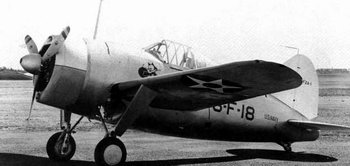![]() The Pacific War Online Encyclopedia
The Pacific War Online Encyclopedia
|
| Previous: F1M2 "Pete", Japanese Reconnaissance Floatplane | Table of Contents | Next: F3F, U.S. Fighter |

Brewster F2A-3 Buffalo
|
Crew |
1 |
|
Dimensions |
35'1" by 26'3" by
12'2" 10.69m by 8.00m by 3.71m |
|
Wing area |
209 square feet 19.4 square meter |
|
Weight |
4732-7159 lbs 2146-3247 kg |
| One 1100 hp (820 kW) Wright R-1820-40
(G-205A)
Cyclone nine-cylinder radial driving a three bladed propeller |
|
|
Maximum speed |
300 mph (483 km/h) at 16,500 feet (5030 meters) 284 mph (526 km/h) at sea level. |
|
Landing speed |
81 mph 150 km/h |
|
Takeoff length |
230/508 feet 70/155 meters |
|
Rate of climb |
41 feet per second 12.5 meters per second |
|
Ceiling |
30,500 feet 9300 meters |
|
Armament |
2 wing 0.50
machine guns 2 fuselage 0.50 machine guns |
|
Range |
965 miles (1550km) at 171 mph (275km/h) or 7.0 hours
normal Maximum 1680 miles (2700km) |
|
Fuel |
240 gallons 908 liters |
| 11 F2A-1, 43 F2A-2 and 108
F2A-3 from 12/8/39 to 4/42 by Brewster Aircraft Company, Long Island
City, NY. An additional 170 went to the RAF in Malaya and 72 to the Netherlands East Indies as the B-339. |
|
|
Variants |
The –1 was armed with one 0.50 and one 0.30 machine gun. The –2 lacked armor and self-sealing fuel tanks. |
The Brewster Buffalo was the U.S.
Navy’s first monoplane carrier fighter.
As such its performance was much
better than any previous Navy fighter. It was also exported in some
numbers, and was much liked
by Finnish pilots who
received the aircraft during the Winter War of 1939-40, suggesting it
was a good aircraft in its day. However, such was the pace of fighter
development that the Buffalo was
obsolescent by 1941, and
it became notorious for its poor combat record over Malaya,
the Netherlands
East Indies, and Midway. One historian has described it as "a true air inferiority fighter" (Spick 1997).
The first prototype flew in December 1937, after
two years of development, and the first production aircraft were
delivered in June 1939. Most of the early production aircraft were
diverted to Finland as the B-239.
A small number of enthusiasts insist that the
Buffalo was a better aircraft than its Pacific combat record suggests.
Descriptions of its flight characteristics by different observers are
contradictory, and one wonders if the addition of self-sealing fuel
tanks, armor, and heavier armament spoiled the performance of later
production models.
References
The Pacific War Online Encyclopedia © 2007, 2009, 2012 by Kent G. Budge. Index